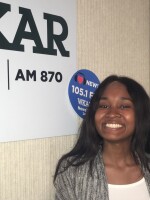This month, several incidents at Michigan State University have highlighted conversations about how safe students of color feel on campus. It’s renewed interest in the need for a safe space. One student organization at MSU wants to build a freestanding multicultural center.
Students for a Multicultural Building is a registered student organization lobbying for Michigan State University to create a larger free standing space for students and faculty of different cultures. In 2018, MSU welcomed its most diverse incoming freshmen class. More than 20 percent of MSU students are people of color. The designated multicultural center is shared by 900 student groups.
Not Enough Space
Opening in 1999, The Mosaic: The Multicultural Unity Center, opened its door to students in the lower level of the MSU Union. After 14 years of being located in the basement, they moved to a more prominent space on the second floor. However, the new space holds about less than 100 people.

There are many minority registered student organizations on campus that meet across campus in basements because the Mosaic doesn't have the capacity to hold their group. Organizations like the Black Student Alliance, meet in the basement of Hubbard Hall.
Sarah McConville is one of the leaders of Students for a Multicultural Building. She identifies as Latinx and is a part of the Council of Racial and Ethnic Students. McConville says the Latinx population is among the smallest at Michigan State University and and their meetings often fill up the room.
“The space is not big enough to fit those people safely. A lot of the time we have overcrowding issues and to be honest I don’t think our rooms are the best wheelchair accessible wise,” McConville said. “I know in the COPS room which is in the Union, I’ve been told it’s hot in there and the spaces aren’t being utilized because they feel like they can’t function in there."
Groups like the Council of Racial and Ethnic Students and Council of Progressive Students are forced to take their meetings out of the Mosaic to avoid overcrowding. The Mosaic is technically their slotted meeting space. However, with four CORES groups and 13 COPS groups the numbers don’t add up.
Me being a minority and coming to this campus was a big culture shock. I think students of color need a sense of belonging. I think the current campus climate needs a building like this
Miracle Chatman is also one of the leaders for Students for a Multicultural Building. Chatman said creating spaces and building community might help with retention rates of minority students.
“Me being a minority and coming to this campus was a big culture shock,” Chatman said. “I think students of color need a sense of belonging. I think the current campus climate needs a building like this.”
Most Big 10 Schools Have A Standalone Space
Eight of the 14 Big 10 schools have freestanding multicultural buildings including: Rutgers University, University of Michigan, University of Nebraska, University of Iowa, Northwestern University, University of Wisconsin, The Ohio State, and Purdue University. MSU is one of six Big 10 schools without standalone space.

University of Michigan built newest iteration of The Trotter Multicultural Center in 2019. U of M established the multicultural center to students in 1971. The new building is designed to be a space that houses "a supportive environment committed to social justice and diversity," said Trotter center director Julio Cardona.
Nando Felton is a student of color at U of M. He said he finds the center essential to the minority community and uses the space frequently.
“I think it’s super positive, it’s for students who feel marginalized on campus,” Felton said. “Having our space where we feel comfortable to sit there and learn and study is something I think is beneficial to the community.”
Previous Pushes
Advocates for a new space at MSU include spartan faculty. Dr. Lee June is a professor at the school. With more than 40 years under his belt at the university, he said he remembers an earlier push for a designated space for multicultural students and has tips for this effort.
They need to be systematic and need to come with a great rationale that will positively effect what such a center would bring not only students of color but the entire university
“They need to be systematic and need to come with a great rationale that will positively effect what such a center would bring not only students of color but the entire university,” June said.
“I’ve done some research over the years and have tracked the usage of these facilities and we do see that research clearly shows that students of color use these at higher rates, but we also see that non students of color make use of that space. So while it’s a home for maybe, students of color, it’s also something that’s positive for the entire university."
Sarah McConville said she's spoken to many students and staff members and they’ve all expressed that they would love to have a space where people can connect and learn about each other.
“I think to learn about people in an non-artificial way, to have a place where we can all hang out and get to know each other organically would create collaborative events that would appear more naturally,” McConville said.
Emily Gerkin-Guerrant is the MSU Spokesperson. She said that the university is aware of the student desire for a designated multicultural building. However, Gerkin-Guerrant said nothing has been brought to the university for review.
Students for a Multicultural Building say they plan to present a proposal to the Board of Trustees by the end of the school year.
Follow Tamia on Twitter: @Tamiamb




